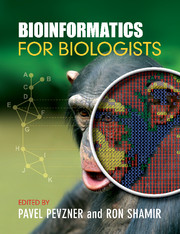Book contents
- Frontmatter
- Contents
- Extended contents
- Preface
- Acknowledgments
- Editors and contributors
- A computational micro primer
- PART I Genomes
- 1 Identifying the genetic basis of disease
- 2 Pattern identification in a haplotype block
- 3 Genome reconstruction: a puzzle with a billion pieces
- 4 Dynamic programming: one algorithmic key for many biological locks
- 5 Measuring evidence: who's your daddy?
- PART II Gene Transcription and Regulation
- PART III Evolution
- PART IV Phylogeny
- PART V Regulatory Networks
- REFERENCES
- Glossary
- Index
3 - Genome reconstruction: a puzzle with a billion pieces
from PART I - Genomes
Published online by Cambridge University Press: 05 June 2012
- Frontmatter
- Contents
- Extended contents
- Preface
- Acknowledgments
- Editors and contributors
- A computational micro primer
- PART I Genomes
- 1 Identifying the genetic basis of disease
- 2 Pattern identification in a haplotype block
- 3 Genome reconstruction: a puzzle with a billion pieces
- 4 Dynamic programming: one algorithmic key for many biological locks
- 5 Measuring evidence: who's your daddy?
- PART II Gene Transcription and Regulation
- PART III Evolution
- PART IV Phylogeny
- PART V Regulatory Networks
- REFERENCES
- Glossary
- Index
Summary
While we can read a book one letter at a time, biologists still lack the ability to read a DNA sequence one nucleotide at a time. Instead, they can identify short fragments (approximately 100 nucleotides long) called reads; however, they do not know where these reads are located within the genome. Thus, assembling a genome from reads is like putting together a giant puzzle with a billion pieces, a formidable mathematical problem. We introduce some of the fascinating history underlying both the mathematical and the biological sides of DNA sequencing.
Introduction to DNA sequencing
DNA sequencing and the overlap puzzle
Imagine that every copy of a newspaper has been stacked inside a wooden chest. Now imagine that chest being detonated. We will ask you to further suspend your disbelief and assume that the newspapers are not all incinerated, as would assuredly happen in real life, but rather that they explode cartoonishly into tiny pieces of confetti (Figure 3.1). We will concern ourselves only with the immediate journalistic problem at hand: what did the newspaper say?
This “newspaper problem” becomes intellectually stimulating when we realize that it does not simply reduce to gluing the remnants of newspaper as we would fit together the disjoint pieces of a jigsaw puzzle. One reason why this is the case is that we have probably lost some information from each copy (the content that was blown to smithereens).
Information
- Type
- Chapter
- Information
- Bioinformatics for Biologists , pp. 36 - 65Publisher: Cambridge University PressPrint publication year: 2011
Accessibility standard: Unknown
Why this information is here
This section outlines the accessibility features of this content - including support for screen readers, full keyboard navigation and high-contrast display options. This may not be relevant for you.Accessibility Information
- 2
- Cited by
